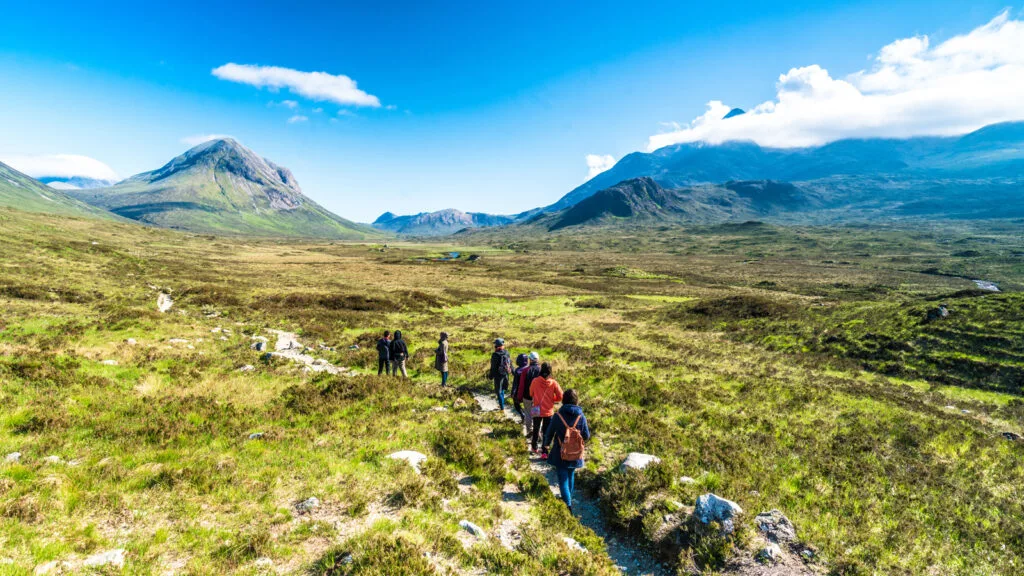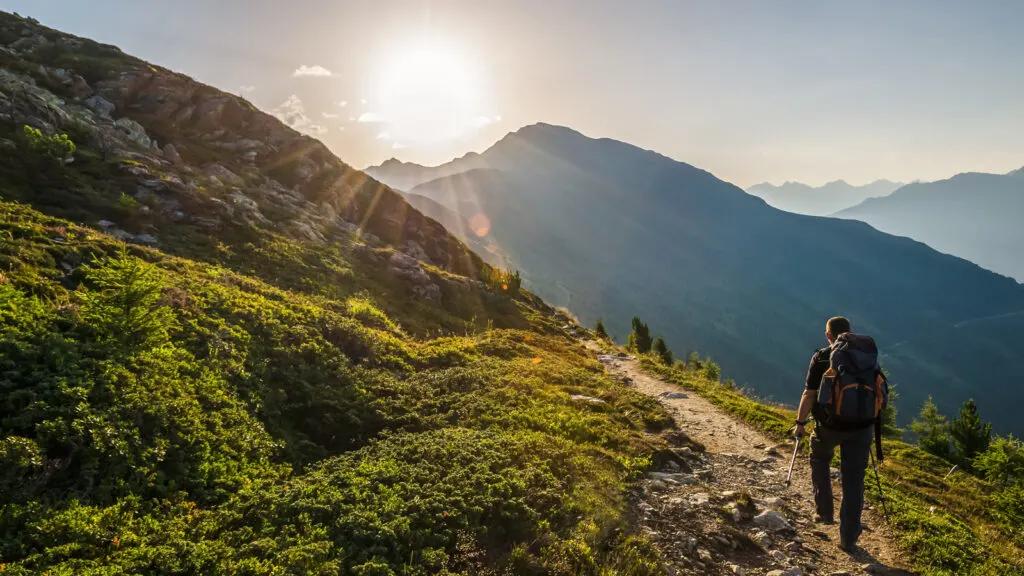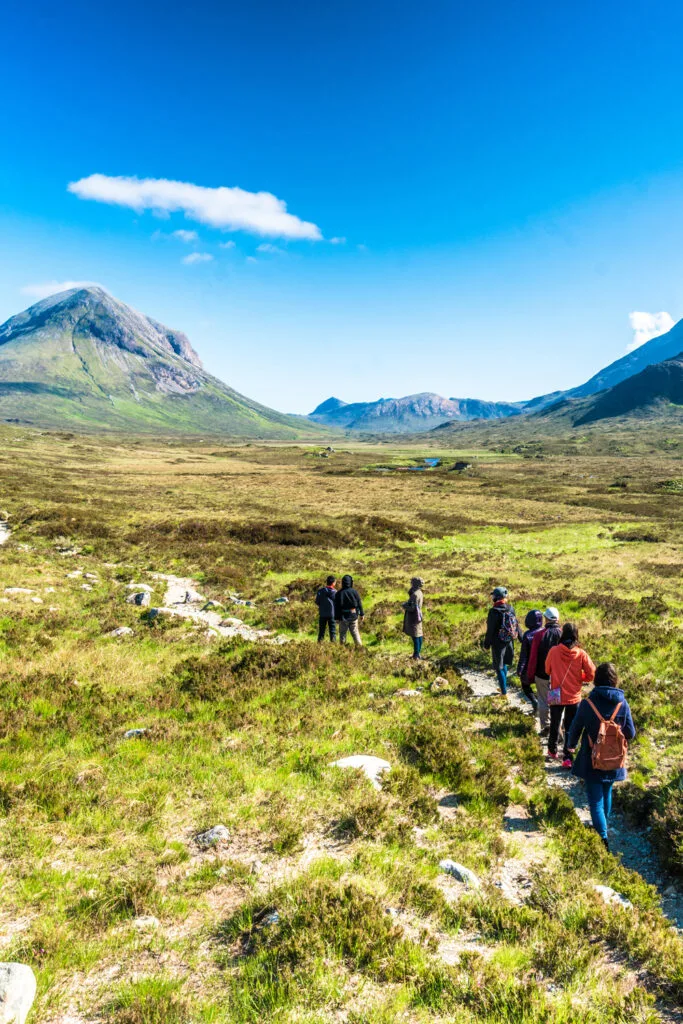Top of the list of things to think about when you’re planning a hike is how long it’s going to take. If you’re out on the trail for longer than expected you can run out of food and water, or even get benighted. While that’s not very likely on a short hike, it’s still best to know the timings for your hike. So, how long does it take to hike 5 miles?
How long does a 5-mile hike take?
For the average hiker, a 5-mile hike on a good, flat path will take one hour and forty minutes. You need to allow a lot longer for steep terrain, a rough trail, lack of fitness, or carrying a heavy pack. Some 5-mile hikes can take as much as 5 hours.
Read on for more details:

Naismith’s Rule
Most walkers and hikers will always refer to Naismith’s Rule when working out how long it will take to complete a five-mile hike. Remarkably this rule dates from the respected Scottish mountaineer William Naismith who conceived his rule in 1892. It’s still used to estimate hiking pace over 130 years later.
A fit individual can walk roughly 3 miles (4.8 km) in an hour, with an additional hour for every 2,000 feet (610 m) of altitude gained.
Naismith’s Rule
Naismith’s Rule is a very rough and ready calculator and many people have tried and failed to refine it. The difficulty is that your hiking pace has so many variables:
Fitness Level
How fit you are will have a big impact on how fast you can hike and the amount of time it will take you to complete your five-mile hike. Naismith’s Rule was based on relatively fit mountaineers – although they were probably wearing leather hobnail boots and carrying heavy climbing packs which must have slowed them down. The problem is there is no such thing as an average person when it comes to your level of fitness. Some people are fast hikers on flat terrain but slow down massively on steep slopes. Other hikers love a good climb – the more feet of elevation gain the better.
If you’re an experienced hiker with a lightweight pack, Naismith’s Rule can seem a bit slow – your average speed can be as high as 4 miles per hour on flat terrain. Any faster than that and you’re power walking or running. For a beginner hike, out for the first time, don’t be surprised if the most you can manage on flat ground is an average walking speed of 2 miles per hour.

Trail Surface
In the English Lake District where I live we love a good bog! Hikes are rarely on an easy trail. Rough terrain will slow you down. Hopping over bogs, climbing through boulder fields, or wading through rivers can turn good trail conditions into a strenuous hike.
Your average hiking speed will be completely different for gentle terrain, moderate terrain, or difficult terrain. That’s why any calculation of hiking speed will only be a rough estimate. If you’re picking your way through boulders on a wilderness hike in Alaska, an average pace of one mile an hour may be as much as you can manage! Your five-mile hike could take as much as 5 hours!
Pack Weight
Start carrying a heavy pack and see the difference in your hiking pace! I always prefer to carry a small backpack on a day hike, but sometimes a large pack is unavoidable. You might be carrying a lot of water for a hike in hot weather, or taking a longer hike into serious mountains where you need to carry a lot of safety equipment.
Hike 5 miles with a big pack and it will really affect your hiking speed – so make allowances. You could be walking as much as 50% slower than your regular walking pace.
Amount Of Elevation Gain
Because Naismith was a mountaineer, he does make a generous allowance for elevation gain. But I still think this rule doesn’t work if you’re climbing really high mountains.
Just think – there’s a big difference between hiking up large hills in Scotland and say the grueling climb up Mount Kinabalu in Borneo that seems to go on forever. There you climb 7,500 feet in just over 5 miles. Even if you have a high fitness level, you can expect your average hiking pace to plummet on such a steep climb. It’s going to really affect hiking time – so allow some extra time for catching your breath if your hike is really steep.

Rest Stops
This brings me nicely around to rest stops. Naismith’s rule doesn’t include rest stops so you’ll need to allow for them as additional hiking time.
Try and work out how many rest breaks you’re likely to take. Generally speaking, a 5-mile hike doesn’t normally take more than a couple of hours. Allowing up to one hour of rest time should be plenty – even with a leisurely lunch stop. For longer hikes, such as a 10-mile hike you may need to allow more time for breaks.
Descending
Think going downhill is the easy part? Think again! Unless your fitness level is high, and you have strong legs from hiking or trail running, descents can be hard work. Add in rough terrain and you need to make allowances to your estimated hiking time. Those downhills can be long and slow, sometimes as difficult as the ups.
Weather Conditions
Finally, the weather conditions on the day will also have an impact on your hiking time. A hot and humid day can really slow you down, especially if you don’t keep hydrated.
Conversely, a cold day can sap your energy levels so you might not hike as fast as normal. And then there are windy days – they can make hiking really hard work, especially if you’re walking into a strong headwind.
The weather can also change the nature of the trail going from good to poor conditions very quickly. Heavy rain will make a trail slippery and difficult to hike. So consider the weather forecast when you’re planning your hike and if the weather forecast is bad it’s best to delay your hike for a better day.

Calculating Your Hiking Pace
Naismith’s Rule is only a guide for the average hiker. When you’re new to hiking it’s difficult to judge how long a five-mile hike will take. One way is to calculate your hiking speed.
Pace and speed are reciprocals. For hiking, your pace is how many minutes it takes to hike a mile and speed is the number of miles you can hike in an hour. If experienced hikers walk a mile in 20 minutes, their pace is 20 mins/mile and their speed is 3 miles/hour.
How To Know Your Hiking Pace
The best way to know your hiking pace is to time yourself on a hike. Start the timer when you begin hiking, and stop it when you reach your destination. Then you can calculate your pace.
You could time yourself on a flat hiking trail walking one mile. This will give you a basic hike time for one mile. Multiply by 5 and you have your time for a 5-mile hike. Add in any extra time for elevation gain, allowances for uneven terrain, and any other factors such as rest stops and pack weight.
This will still be a rough estimate for how long it takes to complete a 5-mile hike but it’s a good starting point.
Use A Trail App
AllTrails is one of several walking apps that store information about other people’s hikes. They’re an excellent way to find out how long your hike will take.
Search for the name of your next hike in AllTrails and it will tell you the average hiking time to complete.
For example one of my local hikes is Mallen Dodd to Skiddaw and back. It’s a 6-mile hike (10 km) with 2152 ft (656m) elevation gain. It’s a steep climb but on a good trail.
Using Naismith’s Rule, that’s going to take about 3 hours – 2 hours for distance and 1 hour for elevation. But AllTrails tells us the average time to complete is 3 hours 57 min.
AllTrails and similar hiking apps are excellent resources when you’re planning a hike. You can look through the reviews and often get tips on the trail and even pull up individual hiking times. It’s my go-to resource if I’m planning a hike in an unknown area.

One Last Tip – Pace Yourself
If you’re new to hiking five miles can feel a long way, so don’t set off too fast. Pace yourself! This way you’ll hike five miles without getting exhausted. Don’t get carried away trying to keep up with other hikers on a popular trail – go at your own pace.

